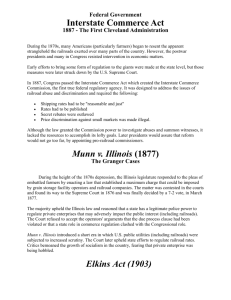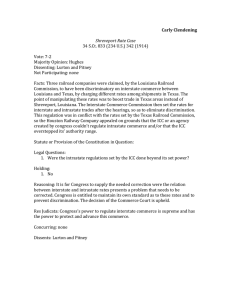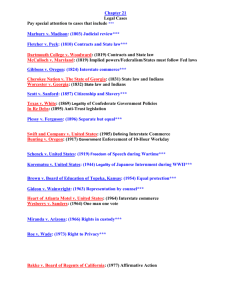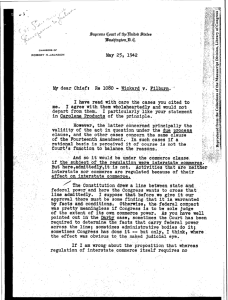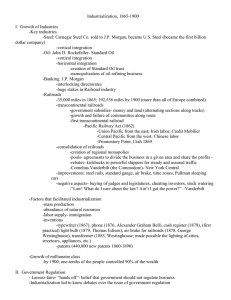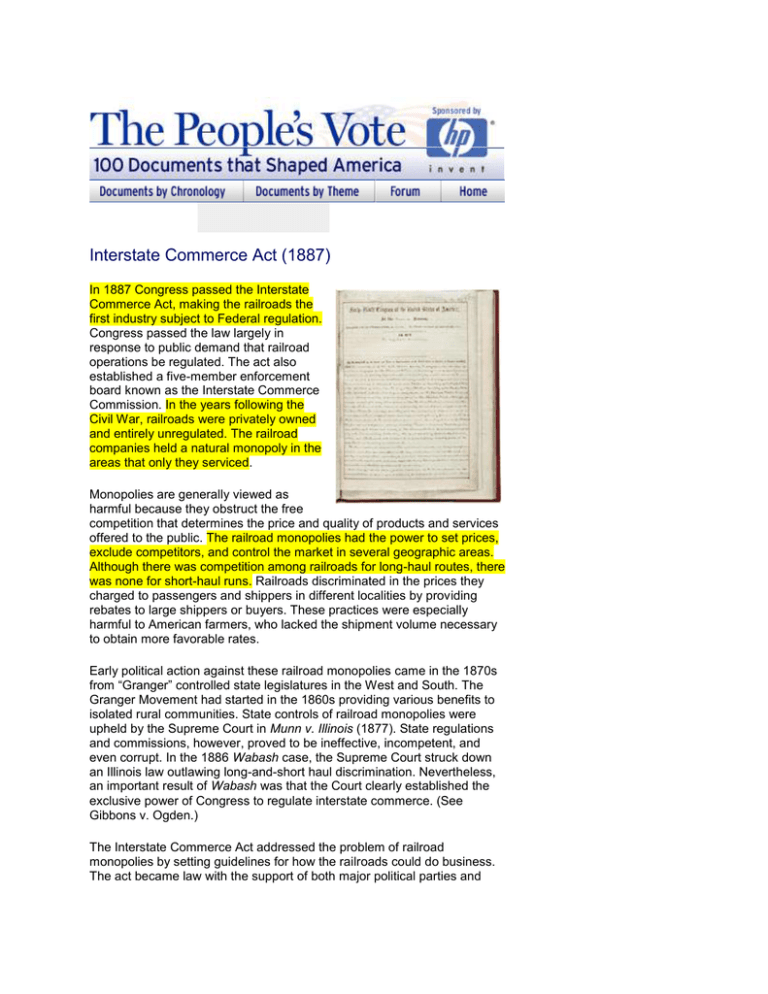
Interstate Commerce Act (1887)
In 1887 Congress passed the Interstate
Commerce Act, making the railroads the
first industry subject to Federal regulation.
Congress passed the law largely in
response to public demand that railroad
operations be regulated. The act also
established a five-member enforcement
board known as the Interstate Commerce
Commission. In the years following the
Civil War, railroads were privately owned
and entirely unregulated. The railroad
companies held a natural monopoly in the
areas that only they serviced.
Monopolies are generally viewed as
harmful because they obstruct the free
competition that determines the price and quality of products and services
offered to the public. The railroad monopolies had the power to set prices,
exclude competitors, and control the market in several geographic areas.
Although there was competition among railroads for long-haul routes, there
was none for short-haul runs. Railroads discriminated in the prices they
charged to passengers and shippers in different localities by providing
rebates to large shippers or buyers. These practices were especially
harmful to American farmers, who lacked the shipment volume necessary
to obtain more favorable rates.
Early political action against these railroad monopolies came in the 1870s
from “Granger” controlled state legislatures in the West and South. The
Granger Movement had started in the 1860s providing various benefits to
isolated rural communities. State controls of railroad monopolies were
upheld by the Supreme Court in Munn v. Illinois (1877). State regulations
and commissions, however, proved to be ineffective, incompetent, and
even corrupt. In the 1886 Wabash case, the Supreme Court struck down
an Illinois law outlawing long-and-short haul discrimination. Nevertheless,
an important result of Wabash was that the Court clearly established the
exclusive power of Congress to regulate interstate commerce. (See
Gibbons v. Ogden.)
The Interstate Commerce Act addressed the problem of railroad
monopolies by setting guidelines for how the railroads could do business.
The act became law with the support of both major political parties and
pressure groups from all regions of the country. Applying only to railroads,
the law required "just and reasonable" rate changes; prohibited special
rates or rebates for individual shippers; prohibited "preference" in rates for
any particular localities, shippers, or products; forbade long-haul/short-haul
discrimination; prohibited pooling of traffic or markets; and most important,
established a five-member Interstate Commerce Commission (ICC).
The law’s terms often contradicted one another. Some provisions were
designed to stimulate competition and others to penalize it. In practice, the
law was not very effective. The most successful provisions of the law were
the requirement that railroads submit annual reports to the ICC and the ban
on special rates the railroads would arrange among themselves, although
determining which rates were discriminatory was technically and politically
difficult. Years later the ICC would become the model for many other
regulatory agencies, but in 1887 it was unique. The Interstate Commerce
Act challenged the philosophy of laissez-faire economics by clearly
providing the right of Congress to regulate private corporations engaged in
interstate commerce. The act, with its provision for the ICC, remains one of
America’s most important documents serving as a model for future
government regulation of private business.
49
49
Copyright © 2003 U.S. News & World Report, L.P. All rights reserved.
Sponsored by the National Archives, National History Day, and U.S.News & World Report in
coordination with USA Freedom Corps



